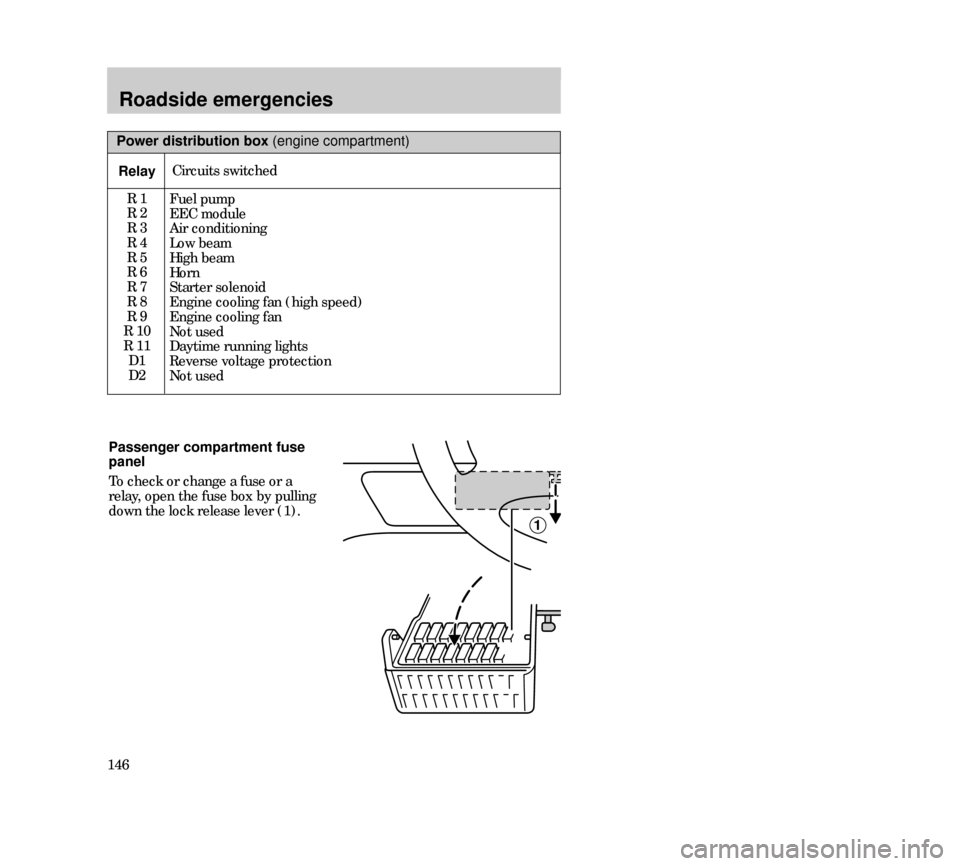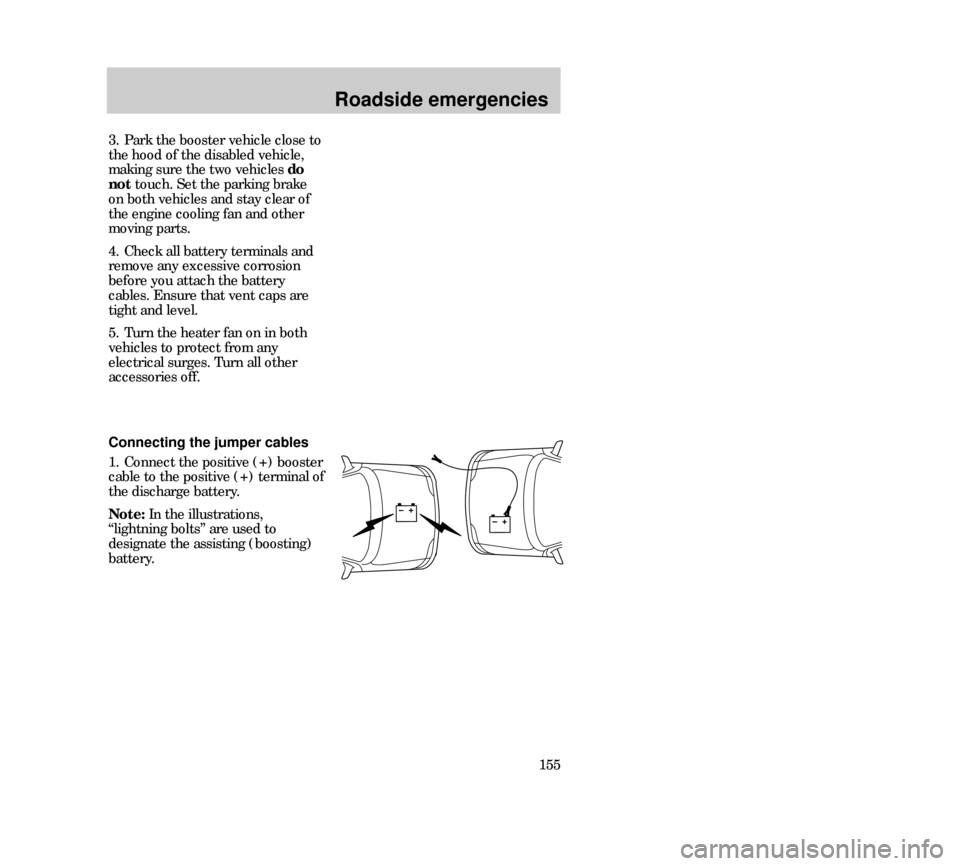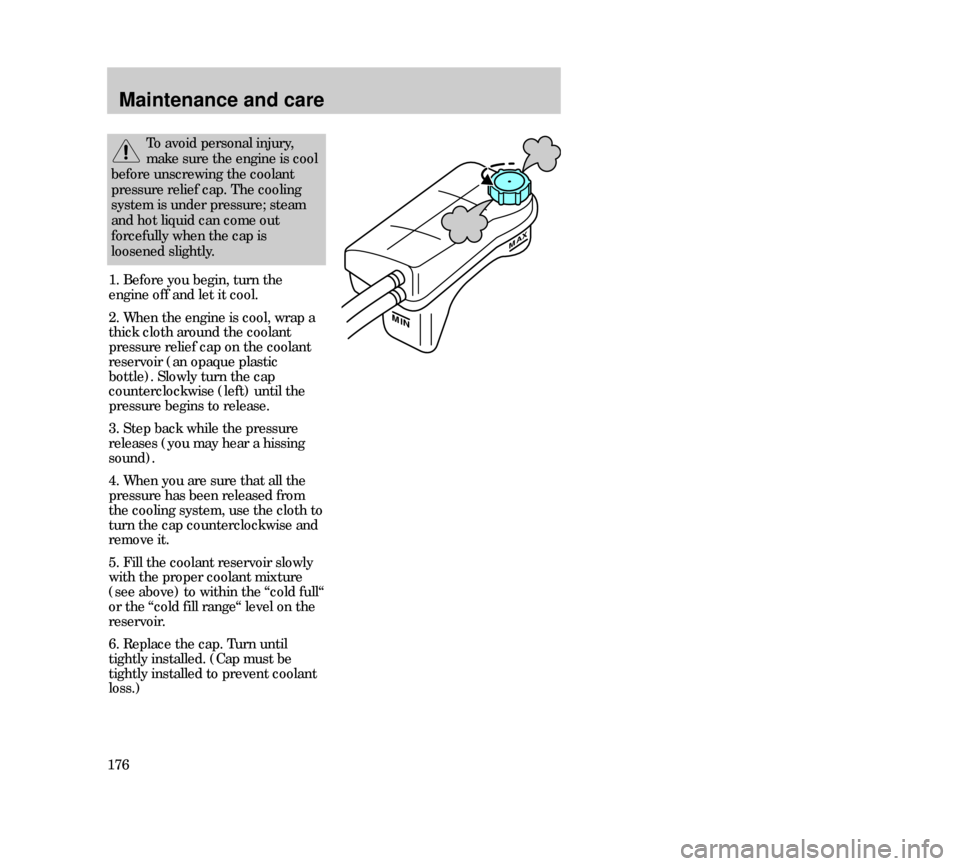light Mercury Mystique 2000 s Service Manual
[x] Cancel search | Manufacturer: MERCURY, Model Year: 2000, Model line: Mystique, Model: Mercury Mystique 2000Pages: 248, PDF Size: 2.2 MB
Page 146 of 248

Roadside emergencies
146Passenger compartment fuse
panel
To check or change a fuse or a
relay, open the fuse box by pulling
down the lock release lever (1).
1
Power distribution box (engine compartment)
RelayCircuits switched
R 1
R 2
R 3
R 4
R 5
R 6
R 7
R 8
R 9
R 10
R 11
D1
D2
Fuel pump
EEC module
Air conditioning
Low beam
High beam
Horn
Starter solenoid
Engine cooling fan (high speed)
Engine cooling fan
Not used
Daytime running lights
Reverse voltage protection
Not used
23MREen 24.6.99 15:28 Uhr Seite 146
Page 147 of 248

Roadside emergencies
147 A blown fuse can be identified by a
break in the wire.
All fuses are a push fit.
Five reserve fuses with different
current ratings are attached to the
inside cover of the power
distribution box in case of
emergency fuse replacement.
19 20 21R16 R15
R14 R12R13
22 23 24 25 26 27 28
29 30 31 32 33 34 35 36 37 38
D2
Passenger compartment fuse panel (below instrument panel)
Relay
Circuit switched
R 12
R 13
R 14
R 15
R 16
D 2Interior lighting
Rear window defrost
Heater blower motor
Wiper motor
Ignition
Reverse voltage protection
23MREen 24.6.99 15:28 Uhr Seite 147
Page 148 of 248

Roadside emergencies
148
19
20
21
22
23
24
25
26
27
28
29
30
31
32
33
34
35
36
37
38—
C10
40
—
15
15
20
7.5
15
30
30
7.5
7.5
7.5
7.5
7.5
7.5
—
30
—Not used
Wiper motors (circuit breaker)
Power windows
Not used
Backup lamps
Brake lamps
Door locks
Main light
Cigar lighter
Electric seats
Rear window defrost
Engine management system
Instrument panel illumination
Radio
Parking lamps - driver’s side
Interior lighting/electric mirror
adjustment
Parking lamps - passenger’s side
Not used
Heater blower motor
Not used
Passenger compartment fuse panel (below instrument panel)
FuseAmpere
ratingCircuits protected
23MREen 24.6.99 15:28 Uhr Seite 148
Page 149 of 248

Roadside emergencies
Fuse rating
7.5 amp
10 amp
15 amp
20 amp
30 amp
30 amp fuse link
40 amp
60 amp fuse link
80 amp fuse link
100 amp fuse linkColor
brown
red
light blue
yellow
light green
pink
orange
yellow
black
blue
Relay
R 18
R 20
R 21
R 22
R 23
R 24
R 25
R 26
R 32
“One touch” switch
(driver’s window)
Not used
Not used
Foglamps
Turn signals
Panic alarm –
driver’s side
Panic alarm –
right-hand side
Not used
Hego heater controlDriver’s door
—
—
Wire shield on instrument panel
Steering column
Door lock module bracket
Door lock module bracket
—
Near PCM-Module
Circuits switchedLocation Standard fuse amperage ratings
and colors
3 amp violet
Auxiliary relays (outside of fuse boxes)
149
23MREen 24.6.99 15:28 Uhr Seite 149
Page 150 of 248

Roadside emergencies
150
CHANGING TIRES
Park your vehicle in such a position
that neither the traffic nor you are
hindered or endangered when
changing the tire. Ensure that the
vehicle is on firm, level ground.
Secure your vehicle further by
blocking the wheels.
Activate the hazard lights.
Apply the parking brake and
engage first or reverse gear if the
vehicle has a manual transaxle or, if
the vehicle has an automatic
transaxle, select the P (Park)
position.
If parking on a slope is unavoidable,
block the wheels.
The temporary spare tire
The vehicle may have a high
pressure temporary spare tire. This
spare is smaller than a regular tire
and is designed for emergency use
only. This tire should be replaced
as soon as possible.
If you use the temporary
spare tire continuously or do
not follow these precautions, the
tire could fail, causing you to lose
control of the vehicle, possibly
injuring yourself or others.
23MREen 24.6.99 15:28 Uhr Seite 150
Page 152 of 248

Roadside emergencies
152Removing a tire
1. Apply the parking brake and 1
(first) gear (manual transaxle) or
the P (Park) position (automatic
transaxle).
2. Activate the hazard flashers.
3. The driver and all passengers
must leave the vehicle.
4. Secure the vehicle against rolling
or sliding.
5. Insert the tapered end of the
jack handle between the rim and
hub cover and push in. Twist off to
remove the cover.
6. Loosen the wheel nuts slightly. Tire changing procedure
7. Place jack with complete support
surface on the ground.
8. The jack must be applied exactly
vertical to the jacking point of the
vehicle.
9. Jack up the vehicle until the tire
is clear of the ground. Unscrew and
remove the wheel nuts and remove
the wheel.
23MREen 24.6.99 15:28 Uhr Seite 152
Page 155 of 248

Roadside emergencies
155
3. Park the booster vehicle close to
the hood of the disabled vehicle,
making sure the two vehicles do
nottouch. Set the parking brake
on both vehicles and stay clear of
the engine cooling fan and other
moving parts.
4. Check all battery terminals and
remove any excessive corrosion
before you attach the battery
cables. Ensure that vent caps are
tight and level.
5. Turn the heater fan on in both
vehicles to protect from any
electrical surges. Turn all other
accessories off.
Connecting the jumper cables
1. Connect the positive (+) booster
cable to the positive (+) terminal of
the discharge battery.
Note:In the illustrations,
“lightning bolts” are used to
designate the assisting (boosting)
battery.
23MREen 24.6.99 15:28 Uhr Seite 155
Page 162 of 248

Maintenance and care
162SERVICE RECOMMENDATIONS
• We highlight do-it-yourself items
in the engine compartment for easy
location.
• As possible, we design parts that
can be replaced without tools.
• We provide you with a
maintenance guide and or service
guide which makes tracking routine
service for your vehicle easy.
If your vehicle requires
professional service, your Ford or
Lincoln/Mercury dealership can
provide necessary parts and
service. Check your “Warranty
Guide” to find out which parts and
services are covered.
Use only recommended fuels,
lubricants, fluids and service parts
conforming to specifications.
Motorcraft parts are designed and
built to provide the best
performance in your vehicle.
31MMCen 24.6.99 15:30 Uhr Seite 162
Page 172 of 248

Maintenance and care
172Brake/clutch fluid reservoir
Brake and clutch fluid systems are
supplied from the same reservoir.
The level of the fluid must lie
between the MIN and MAX marks
on the side of the reservoir. If the
level falls below the MIN mark, the
brake fluid level warning light on
the instrument cluster will
illuminate. Add only DOT 3, DOT 4
or Super DOT 4 brake fluid that
meets the Ford specification (see
the chapter Capacities and
specifications).
If you use brake fluid that is not
DOT 3, DOT 4 or Super DOT 4 you
will cause permanent damage to
your brakes.
MAX
MIN
Brake fluid is toxic.
BRAKE
BRAKE
Do not let the reservoir for
the master cylinder run dry.
This may cause the brakes to fail.
Windshield washer system
If necessary, add enough washer
fluid to fill the reservoir. Follow the
instructions on the washer fluid
label.
Do not put engine coolant in
the container for the
windshield washer fluid.
Alternative design
31MMCen 24.6.99 15:30 Uhr Seite 172
Page 176 of 248

Maintenance and care
176
MAX
MIN
1. Before you begin, turn the
engine off and let it cool.
2. When the engine is cool, wrap a
thick cloth around the coolant
pressure relief cap on the coolant
reservoir (an opaque plastic
bottle). Slowly turn the cap
counterclockwise (left) until the
pressure begins to release.
3. Step back while the pressure
releases (you may hear a hissing
sound).
4. When you are sure that all the
pressure has been released from
the cooling system, use the cloth to
turn the cap counterclockwise and
remove it.
5. Fill the coolant reservoir slowly
with the proper coolant mixture
(see above) to within the “cold full“
or the “cold fill range“ level on the
reservoir.
6. Replace the cap. Turn until
tightly installed. (Cap must be
tightly installed to prevent coolant
loss.)
To avoid personal injury,
make sure the engine is cool
before unscrewing the coolant
pressure relief cap. The cooling
system is under pressure; steam
and hot liquid can come out
forcefully when the cap is
loosened slightly.
31MMCen 24.6.99 15:30 Uhr Seite 176